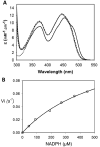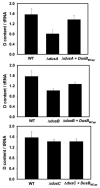Dihydrouridine synthesis in tRNAs is under reductive evolution in Mollicutes
- PMID: 33685366
- PMCID: PMC8632129
- DOI: 10.1080/15476286.2021.1899653
Dihydrouridine synthesis in tRNAs is under reductive evolution in Mollicutes
Abstract
Dihydrouridine (D) is a tRNA-modified base conserved throughout all kingdoms of life and assuming an important structural role. The conserved dihydrouridine synthases (Dus) carries out D-synthesis. DusA, DusB and DusC are bacterial members, and their substrate specificity has been determined in Escherichia coli. DusA synthesizes D20/D20a while DusB and DusC are responsible for the synthesis of D17 and D16, respectively. Here, we characterize the function of the unique dus gene encoding a DusB detected in Mollicutes, which are bacteria that evolved from a common Firmicute ancestor via massive genome reduction. Using in vitro activity tests as well as in vivo E. coli complementation assays with the enzyme from Mycoplasma capricolum (DusBMCap), a model organism for the study of these parasitic bacteria, we show that, as expected for a DusB homolog, DusBMCap modifies U17 to D17 but also synthetizes D20/D20a combining therefore both E. coli DusA and DusB activities. Hence, this is the first case of a Dus enzyme able to modify up to three different sites as well as the first example of a tRNA-modifying enzyme that can modify bases present on the two opposite sides of an RNA-loop structure. Comparative analysis of the distribution of DusB homologs in Firmicutes revealed the existence of three DusB subgroups namely DusB1, DusB2 and DusB3. The first two subgroups were likely present in the Firmicute ancestor, and Mollicutes have retained DusB1 and lost DusB2. Altogether, our results suggest that the multisite specificity of the M. capricolum DusB enzyme could be an ancestral property.
Keywords: dihydrouridine; mollicutes; multisite-specificity; post-transcriptional modification; tRNA.
Conflict of interest statement
No potential conflict of interest was reported by the authors.
Figures







Similar articles
-
The Dihydrouridine landscape from tRNA to mRNA: a perspective on synthesis, structural impact and function.RNA Biol. 2022 Jan;19(1):735-750. doi: 10.1080/15476286.2022.2078094. RNA Biol. 2022. PMID: 35638108 Free PMC article. Review.
-
Unveiling structural and functional divergences of bacterial tRNA dihydrouridine synthases: perspectives on the evolution scenario.Nucleic Acids Res. 2018 Feb 16;46(3):1386-1394. doi: 10.1093/nar/gkx1294. Nucleic Acids Res. 2018. PMID: 29294097 Free PMC article.
-
Molecular basis of dihydrouridine formation on tRNA.Proc Natl Acad Sci U S A. 2011 Dec 6;108(49):19593-8. doi: 10.1073/pnas.1112352108. Epub 2011 Nov 28. Proc Natl Acad Sci U S A. 2011. PMID: 22123979 Free PMC article.
-
Differential redox sensitivity of tRNA dihydrouridylation.Nucleic Acids Res. 2024 Nov 27;52(21):12784-12797. doi: 10.1093/nar/gkae964. Nucleic Acids Res. 2024. PMID: 39460624 Free PMC article.
-
RNase P RNA of Mycoplasma capricolum.Mol Biol Rep. 1995-1996;22(2-3):125-9. doi: 10.1007/BF00988716. Mol Biol Rep. 1995. PMID: 8901498 Review.
Cited by
-
Evolutionary Diversity of Dus2 Enzymes Reveals Novel Structural and Functional Features among Members of the RNA Dihydrouridine Synthases Family.Biomolecules. 2022 Nov 26;12(12):1760. doi: 10.3390/biom12121760. Biomolecules. 2022. PMID: 36551188 Free PMC article.
-
The Dihydrouridine landscape from tRNA to mRNA: a perspective on synthesis, structural impact and function.RNA Biol. 2022 Jan;19(1):735-750. doi: 10.1080/15476286.2022.2078094. RNA Biol. 2022. PMID: 35638108 Free PMC article. Review.
-
Mapping the tRNA modification landscape of Bartonella henselae Houston I and Bartonella quintana Toulouse.Front Microbiol. 2024 Mar 13;15:1369018. doi: 10.3389/fmicb.2024.1369018. eCollection 2024. Front Microbiol. 2024. PMID: 38544857 Free PMC article.
-
Functional redundancy in tRNA dihydrouridylation.Nucleic Acids Res. 2024 Jun 10;52(10):5880-5894. doi: 10.1093/nar/gkae325. Nucleic Acids Res. 2024. PMID: 38682613 Free PMC article.
-
Integrative Approach to Probe Alternative Redox Mechanisms in RNA Modifications.Acc Chem Res. 2023 Nov 21;56(22):3142-3152. doi: 10.1021/acs.accounts.3c00418. Epub 2023 Nov 2. Acc Chem Res. 2023. PMID: 37916403 Free PMC article.
References
-
- Suck D, Saenger W, Zechmeister K.. Conformation of the tRNA minor constituent dihydrouridine. FEBS Lett. 1971;12:257–259. - PubMed
-
- Dyubankova N, Sochacka E, Kraszewska K, et al. Contribution of dihydrouridine in folding of the D-arm in tRNA. Org Biomol Chem. 2015;13:4960–4966. - PubMed
-
- Kim SH, Suddath FL, Quigley GJ, et al. Three-dimensional tertiary structure of yeast phenylalanine transfer RNA. Science. 1974;185:435–440. - PubMed
Publication types
MeSH terms
Substances
Grants and funding
LinkOut - more resources
Full Text Sources
Other Literature Sources
